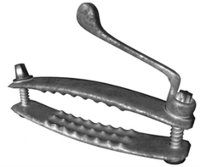 If we are required to place a sensitive part of our anatomy into a device that is designed to apply significant and sustained pressure, then the person controlling the handle would have our complete attention!
If we are required to place a sensitive part of our anatomy into a device that is designed to apply significant and sustained pressure, then the person controlling the handle would have our complete attention!
Our sole objective would be to avoid the crushing and relentless pain and this would most definitely bias our behaviour.
We might say or do things that ordinarily we would not – just to escape from the pain.
The requirement to meet well-intentioned but poorly-designed performance targets can create the organisational equivalent of a medieval thumbscrew; and the distorting effect on behaviour is the same. Some people even seem to derive pleasure from turning the screw!
But what if we do not know how to achieve the performance target? We might then act to deflect the pain onto others – we might become tyrants too – and we might start to apply our own thumbscrews further along the chain of command. Those unfortunate enough to be at the end of the pecking order have nowhere to hide – and that is a deeply distressing place to be – helpless and hopeless.
Fortunately there is a way out of the corporate torture chamber: It is to learn how to design systems to deliver the required performance specification – and learning how to do this is much easier than many believe.
For example, most assume without question that big queues and long waits are always caused by inefficient use of available capacity – because that is what their monitoring systems report. So out come thumbscrews heralded by the chanted mantra “increase utilisation, increase utilisation”. Unfortunately, this belief is only partially correct: low utilisation of available capacity can and does lead to big queues and long waits but there is a much more prevalent and insidious cause of long waits that has nothing to do with capacity or utilisation. These little beasties are are called time-traps.
The essential feature of a time trap is that it is independent of both flow and time – it adds the same amount of delay irrespective of whether the flow is low or high and irrespective of when the work arrives. In contrast waits caused by insufficient capacity are flow and time dependent – the higher the flow the longer the wait – and the effect is cumulative over time.
Many confuse the time-trap with its close relative the batch – but they are not the same thing at all – and most confuse both of these with capacity-constraints which are a completely different delay generating beast altogether.
The distinction is critical because the treatments for time-traps, batches and capacity-constraints are different – and if we get the diagnosis wrong then we will make the wrong decision, choose the wrong action, and our system will get sicker, or at least no better. The corporate pain will continue and possibly get worse – leading to even more bad behaviour and more desperate a self-destructive strategies.
So when we want to reduce lead times by reducing waiting-in-queues then the first thing we need to do is to search for the time-traps, and to do that we need to be able to recognise their characteristic footprint on our time-series charts; the vital signs of our system.
We need to learn how to create and interpret the charts – and to do that quickly we need guidance from someone who can explain what to look for and how to interpret the picture.
If we lack insight and humility and choose not to learn then we are choosing to stay in the target-tyranny-trap and our pain will continue.


